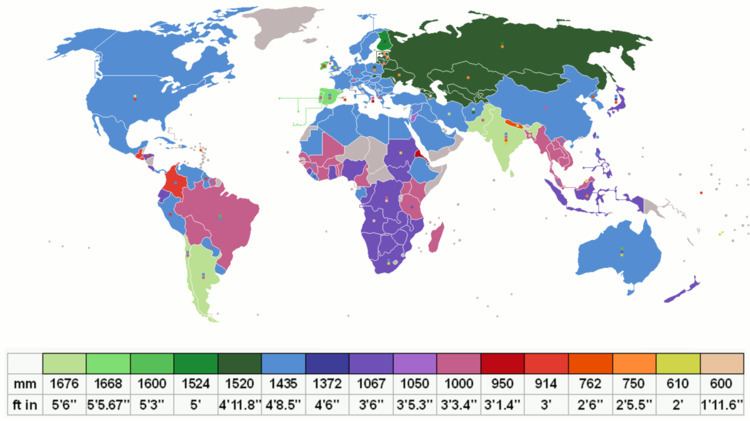 | ||
The 4 ft 6 in (1,372 mm) track gauge, also called the Scotch gauge, was adopted by early 19th century railways mainly in the Lanarkshire area of Scotland. It differed from the gauge of 4 ft 8 in (1,422 mm) that was used on some early lines in England. Early railways chose their own gauge, but later in the century interchange of equipment was facilitated by establishing a uniform rail gauge across railways: a so-called 'standard gauge' of 4 ft 8 1⁄2 in (1,435 mm). In the early 1840s standard gauge lines began to be constructed in Scotland, and all the Scotch Gauge lines were eventually converted to standard gauge. The gauge was outlawed in Great Britain by law in 1846. From 1903, tram lines of Tokyo adopted this gauge.
Contents
Scottish railways built to Scotch gauge
A small number of early to mid-19th century passenger railways were built to 4 ft 6 in (1,372 mm) Scotch gauge including:
Interestingly Robert Stephenson and Company built a Scotch gauge locomotive, the St. Rollox, for the Garnkirk and Glasgow Railway; which was later sold to the Paisley and Renfrew Railway.
All the lines were later relaid in standard gauge.
4 ft 6½ in gauge
In addition to the above lines, there were three railways, authorised between 1822 and 1835, that were built in the Dundee area, to a gauge of 4 ft 6 1⁄2 in (1,384 mm). They were:
5 ft 6 in gauge
Grainger and Miller built another two railway lines in the same area to a gauge of 5 ft 6 in (1,676 mm). Thomas Grainger is said to have chosen this gauge, since he regarded 4 ft 8 1⁄2 in (1,435 mm) standard gauge as being too narrow and Isambard Kingdom Brunel's 7 ft 1⁄4 in (2,140 mm) Brunel gauge as being too wide. They were:
End of Scotch gauge
The Glasgow, Paisley, Kilmarnock and Ayr Railway and the Glasgow, Paisley and Greenock Railway, which both obtained Parliamentary Approval on 15 July 1837 and were later to become part of the Glasgow and South Western Railway and the Caledonian Railway, respectively, were built to standard gauge from the start.
The standard gauge of 4 ft 8 1⁄2 in (1,435 mm), also known as the Stephenson gauge after George Stephenson, was adopted in Great Britain after 1846 after the passing of the Regulating the Gauge of Railways Act 1846. A few remnants of old lines remain, but are non functional with the exception of one example of the St Michael's Mount Tramway at St Michael's Mount in Cornwall. It is a partial underground railway that used to bring luggage up to the castle. It occasionally operates, but only for demonstration reasons and is not open to the general public, although a small stretch is visible at the harbour. It is therefore believed to be Britain's last functionally operational Scotch gauge railway.
Use in Japan
After the end of Scotch gauge in Britain, the gauge was revived in Japan. Since 1903, most of tram network in Tokyo was built with 4 ft 6 in (1,372 mm) rail gauge, called "coach gauge" (馬車軌間, Basha Kikan). The use of this gauge extended to other suburban lines that projected through services to the city tram. Although Tokyo has abolished its major tram network, as of 2009, the following lines still use this gauge:
